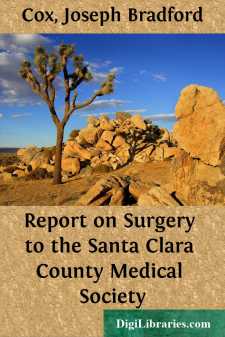Categories
- Antiques & Collectibles 13
- Architecture 36
- Art 48
- Bibles 22
- Biography & Autobiography 813
- Body, Mind & Spirit 142
- Business & Economics 28
- Children's Books 14
- Children's Fiction 11
- Computers 4
- Cooking 94
- Crafts & Hobbies 4
- Drama 346
- Education 46
- Family & Relationships 57
- Fiction 11829
- Games 19
- Gardening 17
- Health & Fitness 34
- History 1377
- House & Home 1
- Humor 147
- Juvenile Fiction 1873
- Juvenile Nonfiction 202
- Language Arts & Disciplines 88
- Law 16
- Literary Collections 686
- Literary Criticism 179
- Mathematics 13
- Medical 41
- Music 40
- Nature 179
- Non-Classifiable 1768
- Performing Arts 7
- Periodicals 1453
- Philosophy 64
- Photography 2
- Poetry 896
- Political Science 203
- Psychology 42
- Reference 154
- Religion 513
- Science 126
- Self-Help 84
- Social Science 81
- Sports & Recreation 34
- Study Aids 3
- Technology & Engineering 59
- Transportation 23
- Travel 463
- True Crime 29
Report on Surgery to the Santa Clara County Medical Society
Categories:
Description:
Excerpt
Report on Surgery.
In presenting this report I will not attempt to give any historical data connected with the subject of surgery, since that has been ably done in the report of last year.
I shall assume, and that without hesitation, that surgery is a science, properly so-called. That it is an art, is also true. But what is science? What is art? Science is knowledge. Art the application of that knowledge. To be more explicit, science is the knowledge we possess of nature and her laws; or, more properly speaking, God and His laws.
When we say that oxygen and iron unite and form ferric oxide, we express a law of matter: that is, that these elements have an affinity for each other. A collection of similar facts and their systematic arrangement, we call chemistry. Or we might say, chemistry is the science or knowledge of the elementary substances and their laws of combination.
When we say that about one-eighth of the entire weight of the human body is a fluid, and is continually in motion within certain channels called blood vessels, we express a law of life, or a vital process. When we say this fluid is composed of certain anatomical elements, as the plasma, red corpuscles, leucocytes and granules, we go a step further in the problem of vitality. When we say that certain nutritious principles are taken into this circulating fluid by means of digestion and absorption, and that by assimilation they are converted into the various tissues of the body, we think we have solved the problem, and know just the essence of life itself. But what makes the blood hold these nutritious principles in solution until the very instant they come in contact with the tissue they are designed to renovate, and then, as it were, precipitate them as new tissue? You say they are in chemical solution, and the substance of contact acts as a re-agent, and thus the deposit of new tissue is only in accordance with the laws of chemistry. Perhaps this is so. Let us see as to the proofs. In the analysis of the blood plasma, we find chlorides of sodium, potassium and ammonium, carbonates of potassa, soda, lime and magnesia, phosphates of lime, magnesia, potassa, and probably iron; also basic phosphates and neutral phosphates of soda, and sulphates of potassa and soda. Now in the analysis of those tissues composed principally of inorganic substances or compounds, it will be seen that these same salts are found in the tissues themselves.
So also the organic compounds lactate of soda, lactate of lime, pneumate of soda, margarate of soda, stearate of soda, butyrate of soda, oleine, margarine, stearine, lecethine, glucose, inosite, plasmine, serine, peptones, etc., are found alike in the tissues and in the blood plasma. That they are in solution in the plasma is well known,—that they are in a solid or precipitated form in the tissues is also true,—and that the tissues are supplied from the blood is also evident,—because the blood is the only part that receives supplies of material direct from the food taken and digested....


